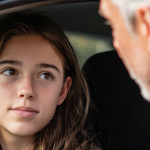Helping you teach your teen to drive safely.
 Your teen’s license isn’t the end of your role—it’s the start of a new phase of coaching. While you won’t be in the passenger seat every time, occasional ride-alongs can be one of the most effective ways to keep safety top of mind. During these check-in drives, watch for key indicators of safe habits: steady…
Your teen’s license isn’t the end of your role—it’s the start of a new phase of coaching. While you won’t be in the passenger seat every time, occasional ride-alongs can be one of the most effective ways to keep safety top of mind. During these check-in drives, watch for key indicators of safe habits: steady…
 Even the most careful new drivers tend to repeat certain mistakes. The earlier these habits are spotted and corrected, the safer your teen will be when they’re driving solo. Speeding is one of the most common issues. For many teens, it’s not about thrill-seeking—it’s a misjudgment of how fast they’re actually going, especially when moving from…
Even the most careful new drivers tend to repeat certain mistakes. The earlier these habits are spotted and corrected, the safer your teen will be when they’re driving solo. Speeding is one of the most common issues. For many teens, it’s not about thrill-seeking—it’s a misjudgment of how fast they’re actually going, especially when moving from…
 The day your teen drives away without you in the passenger seat is a milestone—but also the start of the most dangerous phase of their driving life. The first 6–12 months of solo driving carry the highest crash risk, largely due to distractions, inexperience, and overconfidence. Setting clear boundaries before they ever drive alone is…
The day your teen drives away without you in the passenger seat is a milestone—but also the start of the most dangerous phase of their driving life. The first 6–12 months of solo driving carry the highest crash risk, largely due to distractions, inexperience, and overconfidence. Setting clear boundaries before they ever drive alone is…
 Many new drivers feel confident in sunny, dry conditions—only to panic when the weather turns. The problem is that without guided exposure to rain, snow, fog, or low-light driving, teens lack the reflexes to respond calmly and safely when conditions change. The safest place for them to learn those skills is with you in the passenger seat,…
Many new drivers feel confident in sunny, dry conditions—only to panic when the weather turns. The problem is that without guided exposure to rain, snow, fog, or low-light driving, teens lack the reflexes to respond calmly and safely when conditions change. The safest place for them to learn those skills is with you in the passenger seat,…
 Technology can be a game-changer in helping parents coach their teens to become safe, confident drivers. But not all tools are created equal—and the most effective ones are those designed to support both skill development and safety awareness throughout the permit period. For many families, the first challenge is simply tracking driving hours and conditions. State…
Technology can be a game-changer in helping parents coach their teens to become safe, confident drivers. But not all tools are created equal—and the most effective ones are those designed to support both skill development and safety awareness throughout the permit period. For many families, the first challenge is simply tracking driving hours and conditions. State…